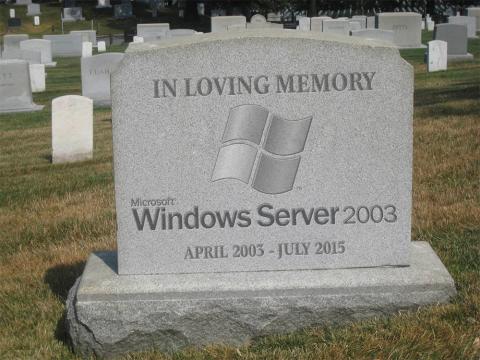With Windows Server 2003 end of life fast approaching, find out why it’s essential to migrate systems sooner rather than later to avoid problems.
The official date for Microsoft to end their support for Server 2003 is July 14 2015. We’ll outline here why businesses ought to update their systems in a timely manner to prevent difficulties and disruption to business operations.
End of Life Impact on Business
For businesses running Windows Server 2003, it’s important to consider the fact that Microsoft will stop releasing security updates and patches; leaving systems open to vulnerability on a network.
High priority should be given to a migration strategy ASAP to protect the IT infrastructure from any risk of attack due to, what will soon come to be, un-patched vulnerabilities.
Another significant consideration is third party vendors also ending their support of their programs running on Windows Server 2003. Resources and efforts to continue to support the soon-to-be legacy operating system will be reduced to focus on supporting newer OS builds.
Why Migrate?
Now is the time to migrate all Server 2003 machines to be sure that:
- Any new vulnerability can be patched and updated to help lock down security.
- All crucial applications can continue to be supported by vendors.
- A newer operating system will also help improve performance.
- Receiving faster response times to any given issue as well as access to quick fixes.
- Complying with HIPAA regulations as it states under section 164.308 (a)(1)(ii)(B) that such security measures need to be in place to lower the risk of vulnerabilities to a manageable degree.
- Complying with PCI section 6.1, which reiterates the same safety measures as HIPAA, stating for all businesses to protect their systems from vulnerabilities by applying updated patches from the vendor.
If a high majority of Servers in a data center run Server 2003 past Microsoft’s end of support period, this will infringe on both HIPPA and PCI regulations, especially for those businesses covered under it.
Windows Server 32-bit Issues
Another known problem to consider is a design flaw of the memory pool for Server 2003 32-bit systems when running newer third party applications.
Any third-party applications running on this particular version of Server 2003 are known to take up paged pool and non-paged-pool memory. The problem arises from these newer applications depleting both paged pool and non-paged pool on the already limited Server 2003 32-bit systems.
This particular problem originates in the boot.ini file which specifies a 3GB limitation option. This setting causes the memory to be first allocated to a program running within the server causing the page-pool or non-page pool memory to diminish. Many newer programs require a larger amount of memory to be “pooled” causing the server to lock-up. This usually leads to a server crash.
Final thoughts
We suggest to plan a migration to Server 2012 R2 or Server 2008 R2 assuming your business operations really need a dedicated server. It can take some time to approve any change requests and to plan a migration within an organization, therefore it’s best to start now to ensure the least amount of disruption to business operations.
For more ways to securely migrate your old systems, contact your local IT professionals.









How did you make that picture?